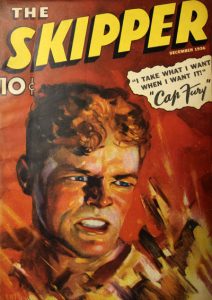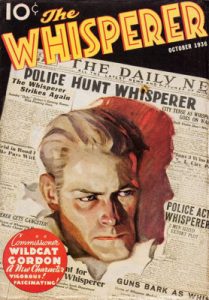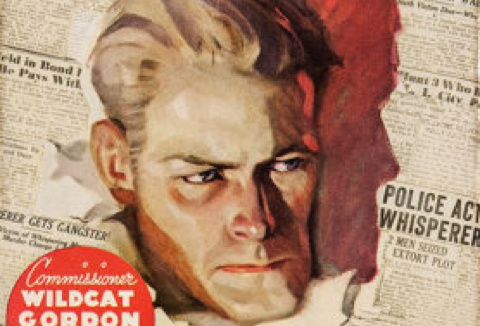 THE SHADOW MAGAZINE kicked off the hero-pulp era with a bang when it debuted in 1931. Pulp publishers — including THE SHADOW‘s publisher, Street & Smith — scrambled to grab a share of that eager reading audience.
THE SHADOW MAGAZINE kicked off the hero-pulp era with a bang when it debuted in 1931. Pulp publishers — including THE SHADOW‘s publisher, Street & Smith — scrambled to grab a share of that eager reading audience.
It took Street & Smith until 1933 to add more character pulps to its lineup: DOC SAVAGE, NICK CARTER MAGAZINE, and PETE RICE MAGAZINE. That same year, Thrilling Publications released THE PHANTOM DETECTIVE and THE LONE EAGLE, while Popular Publications introduced THE SPIDER and G-8 AND HIS BATTLE ACES.
Popular Publications’ THE SPIDER pushed the boundaries set by the other hero pulp magazines, which were rather mainstream. The Spider was judge, jury, and executioner in his battle against crazed, blood-thirsty villains. Other Popular pulps — HORROR STORIES and TERROR TALES — pushed those boundaries even further. The chain’s pulps were “jammed with non-stop violence, like the fever dream of a homicidal maniac,” wrote the late pulp historian Robert Sampson in DEADLY EXCITEMENTS. And as their publisher’s name reflects, these pulps were quite popular. So popular, in fact, that Street & Smith decided it needed to put a harder edge in its hero pulps.
Rather than introduce those themes in its already popular THE SHADOW and DOC SAVAGE magazines, Street & Smith turned to two new hero pulps — THE WHISPERER and THE SKIPPER — to ratchet things up a notch or two.
THE WHISPERER hit the newsstands with an October 1936 number. The Whisperer was police Inspector James “Wildcat” Gordon, who before the end of his first adventure (“The Dead Who Talked”) would be named police commissioner.
The 30-year-old, stocky, granite-jawed policeman attempted to fight crime within the law during the day, but transformed into The Whisperer to take the law into his own hands when it didn’t go far enough. The brash Wildcat Gordon favored equally brash — no, make that garish — suits, often green-checked with bright red ties, a matching carnation, a battered Army campaign hat, and large, yellow shoes. The Whisperer was just the opposite.
Gordon’s crime-fighting alter ego was described as drab, homely, and unassuming. To transform into The Whisperer, Gordon changed into a gray business suit, gray spats, and an old-fashioned round-brimmed hat, dusted his brownish/reddish hair with a white powder, and inserted two dental plates that transformed his square jaw into a long, narrow, and oddly pointed one. The dental plates also caused him to speak in a low but penetrating whisper — hence his name. To aid him in meting out justice, The Whisperer packed two automatics fixed with super-silencers, which hissed and flashed licks of blue flame when fired. At other times, he took pleasure in snapping criminals’ necks with his exceptionally strong hands.
(Oh, does Police Commissioner James Gordon sound familiar? You’re probably thinking of Police Commissioner James Gordon from BATMAN. That’s just one of several links between the comic book Caped Crusader and The Whisperer. Will Murray and Anthony Tollin address how THE WHISPERER and other pulps influenced BATMAN in Sanctum Books‘ reprints of the pulp series.)
When necessary, The Whisperer went undercover as D. Smith, or Dunk Smith, a two-bit crook, who looked just like The Whisperer, but without the hat. He had to moderate his speech, keeping it hoarse and husky, in order not to give himself away. Smith’s dog, a Scottish terrier named Brian Boru, only answered to Gordon when he’s either The Whisperer or Dunk.
Gordon was joined in the magazine by Richard “Quick Trigger” Traeger and his granddaughter (later daughter) Tiny Traeger; his police chauffeur, Horace “Slug” Minor; Detective Sgt. Thorsen; and Judge Patrick Kyley. Thorns in Gordon’s side were Deputy Commissioner Henry Bolton, Gordon’s obnoxious assistant who desperately wanted Gordon’s job, and Van Royston, the foppish mayor who dressed in black tie, tails, and a silk top hat, and would have welcomed Bolton’s promotion.
Despite the hopped-up violence (at least for Street & Smith standards), The Whisperer rarely faced the sorts of villains confronted by The Spider. The Whisperer tackled organized crime, racketeers, political corruption, and the like.
 THE WHISPERER‘s first magazine lasted 14 issues, ending with December 1937. All of those novels were written by Laurence Donovan under the house name Clifford Goodrich. Donovan was an ideal fictioneer for putting an edge on The Whisperer (and The Skipper). He was also writing for the more provocative Spicy line of pulps. After his namesake pulp folded, The Whisperer moved to short stories in the back pages of THE SHADOW MAGAZINE, with one appearance in CRIME BUSTERS, for the next three years. Donovan fell out of favor with Street & Smith in 1938 and was replaced by Alan Hathway as the new Clifford Goodrich.
THE WHISPERER‘s first magazine lasted 14 issues, ending with December 1937. All of those novels were written by Laurence Donovan under the house name Clifford Goodrich. Donovan was an ideal fictioneer for putting an edge on The Whisperer (and The Skipper). He was also writing for the more provocative Spicy line of pulps. After his namesake pulp folded, The Whisperer moved to short stories in the back pages of THE SHADOW MAGAZINE, with one appearance in CRIME BUSTERS, for the next three years. Donovan fell out of favor with Street & Smith in 1938 and was replaced by Alan Hathway as the new Clifford Goodrich.
As the United States became embroiled in World War II, pulp popularity rebounded from a slump in the late 1930s. Street & Smith moved The Whisperer back to his own magazine and restarted the numbering with Vol. 1, No. 1, dated October 1940. The character’s appearance was changed; gone was the drab gray, replaced with black. Murray has speculated that the change may have been to distance The Whisperer from Street’s latest pulp hero, The Avenger, who was also stocky and dressed in gray. The new series lasted ten every-other-month issues, ending the character’s pulp appearances for good with the April 1942 issue.
Two months after the first appearance of the original THE WHISPERER magazine, THE SKIPPER went on sale with a December 1936 cover date. As The Whisperer is often said to have been inspired by The Shadow, there’s little doubt that Captain John Fury — the Skipper — was a variant of Doc Savage.
THE SKIPPER was also written by Laurence Donovan, under the house name Wallace Brooker. Donovan was quite familiar with Doc Savage, having written nine of the Man of Bronze’s adventures from 1935 to 1937.
Cap Fury wasn’t the giant that Doc was; instead he, like Wildcat Gordon, was stocky, but with “flaming red hair” and “sharp arctic blue” eyes. He had Doc-like skills, which included lip-reading, using pressure points to subdue the bad guys, and cat-like agility. He also relied on oversized sea boots to conceal hypodermics, oxygen masks, and other gadgets. His flaming red hair and last name echoed his dealings with the criminal sort. Unlike Doc, who refrained from killing, Cap Fury made good use of automatic pistols and a whip to mete out justice.
Fury sailed a rusted-looking old tanker, the “Whirlwind,” which was actually a state-of-the-art battleship, with deck guns, a fully outfitted laboratory, a hanger with foldable aircraft and a submarine, and elaborate living quarters.
Joining Fury in his adventures were Peter Doom, a former policeman and Fury’s closest associate; James Jonathan “Marlin Spike” Briggs, a Monk Mayfair-like first mate; Hurricane Dan Belmont, the giant second mate; Cock-eye, the third mate; and James “Bumps” McCarthy, “a roly-poly, red-haired” fellow “known as ‘Bumps’ because of his constantly getting himself into jams’ who was a newsreel cameraman that followed Fury around for great film. Princess Mara — Mara von Jean, the Black Leopard Princess — takes the Pat Savage role in the series beginning in January 1937. She turns up occasionally when she’s not at a Boston girls’ school. There’s also G.R.M. “Grump” Rollins, chairman of the board that owned the Whirlwind.
Again, echoing Doc Savage, Fury was drawn into his battle against evil after his brother, Captain John Fury, was murdered by ocean-faring evildoers in his first adventure. Cap Fury vowed to rid the seas of pirates and criminals.
Unlike the routine bad guys that The Whisperer fought, The Skipper battled a number of fantastic foes who controlled death rays, a meteorite that removed oxygen from the air, voodoo practitioners, plague-bearing rats, and other nefarious foes.
When THE SKIPPER was canceled after 12 issues with the December 1937 number, Cap Fury moved into the back pages of DOC SAVAGE MAGAZINE. The shorter stories were written by Donovan, Harold Davis, and Norman Daniels.
(In addition to their pulp appearances, both The Whisperer and The Skipper branched out to backup stories in Street & Smith comic books in the 1940s.)
Learn much more about The Whisperer and Cap Fury at PulpFest 2016. “Summer’s AMAZING Pulp Con” will salute the 80th anniversaries of the two pulp heroes. Pulp historian Will Murray will tell the story of “Street & Smith’s Second Stringers: The Whisperer and The Skipper” at the con. Murray is the 1979 Lamont Award winner, and author of “The Wild Adventures of Doc Savage and Tarzan” for Altus Press. PulpFest 2016 will take place from July 21st through July 24th in the Columbus, Ohio Arena district at the Hyatt Regency hotel and the city’s spacious convention center.
(THE SKIPPER, including the first issue dated December 1936, featured cover art by Lawrence Donner Toney, a graduate of the Art Institute of Chicago. During the 1930s and 1940s, Toney painted covers for pulp magazines, such as CLUES, COMPLETE STORIES, WESTERN STORY MAGAZINE, and WILD WEST WEEKLY, all published by Street & Smith. Most of his work for pulp magazines was signed only with his initials.
THE WHISPERER was introduced to readers with its October 1936 number, featuring front cover art by the talented John Newton Howitt, a devoted landscape painter whose work was sold at fine art galleries in New York City. With the advent of the Great Depression, the artist turned to the pulps for income. An excellent painter, Howitt found a ready market in the rough-paper periodicals, selling freelance pulp covers to ADVENTURE, DIME DETECTIVE, HORROR STORIES, THE SPIDER, TERROR TALES, THE WHISPERER, WESTERN STORY MAGAZINE, and other pulp magazine titles.
To learn more about these talented artists, be sure to visit David Saunders’ Field Guide to Wild American Pulp Artists where you will find more than 300 biographical profiles of American pulp artists.)






